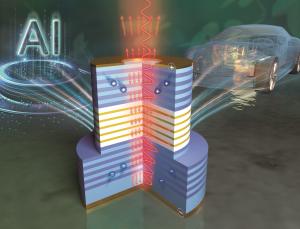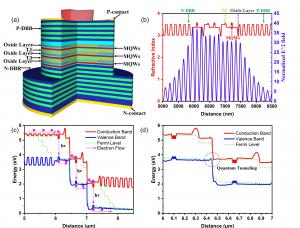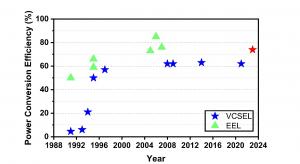Surface Emitting Semiconductor Laser Achieves Efficiency Breakthrough
USA, April 4, 2024 /EINPresswire.com/ -- Since the advent of semiconductor lasers, one of the most striking advantages over other types of lasers is their ability to achieve extremely high electro-optical conversion efficiency. The pursuit of ultrahigh efficiencies in semiconductor lasers remains an important goal in photonics and laser physics. Towards this goal, Scientist in China achieved an efficiency breakthrough in surface-emitting semiconductor lasers through multi-junction active area cascade technology. This technology plays an important role in promoting the development of green energy photonics.
Since its inception, the power conversion efficiency (PCE) of Edge-Emitting Laser (EEL) has been continuously breaking records, achieving a historic high efficiency of 85% at -50°C in 2006. Following this, in 2007, EEL also reached a high efficiency of 76% at room temperature. However, over the next fifteen years, no new efficiency records were set, and these achievements have remained the pinnacle for semiconductor lasers. In contrast, the efficiency improvement of Vertical-Cavity Surface-Emitting Lasers (VCSEL) has been slower. Since reporting a maximum PCE of 62% in 2009, there have been no significant breakthroughs, highlighting a clear performance gap between VCSEL and EEL. As a microcavity laser, achieving high-efficiency conversion in the field of photonics has always been a challenge for VCSEL.
Due to their low power and efficiency, the early applications of VCSELs were primarily focused on small-scale, low-power consumer electronics and short-distance communication in data centers. In recent years, with advancements in smart technology, low-power VCSELs have become a key core light source chip for smart sensing systems, finding widespread application in facial recognition and short-distance sensing with notable success. Recently, the rapid development of advanced artificial intelligence technology has revealed VCSELs' immense potential in various fields such as sensing, communication, atomic clocks, optical/quantum computing, topological lasers, and medical diagnostics. Particularly, the demand for long-range sensing technologies in autonomous driving, AI computational power in high-speed data processing centers, and the growth of VCSELs in smart and quantum technology applications underscore the importance of energy consumption as a core issue. The energy efficiency of VCSELs has a significant impact on the energy consumption of mobile devices and data centers. Therefore, developing ultra-high-efficiency VCSELs is crucial for supporting the development of end devices in the future smart era and plays an important role in advancing the development of green energy photonics.
In a new paper (doi: 10.1038/s41377-024-01403-7) published in Light Science & Application, a team of scientists, led by Professor Jun Wang from College of Electronics and Information Engineering, Sichuan University, China and Suzhou Everbright Photonics Co., Ltd, Suzhou, China, and co-workers have achieved VCSEL efficiency breakthrough using multi-junction cascaded active area technology.
By employing reverse tunnel junctions to realize active region cascading, the gain volume is increased. This design strategy allows carriers to undergo multiple stimulated emission processes, thereby not only enhancing the device's differential quantum efficiency but also maintaining a lower threshold current. As a result, in recent years, a significant number of researchers have leveraged multi-junction VCSELs to achieve exponential power growth, making VCSELs viable as laser sources for LiDAR in autonomous vehicles. However, the most significant potential advantage of multi-junction VCSELs should be their remarkable efficiency improvement. Therefore, a systematic study combining theoretical simulations with experiments is conducted to investigate the advantages of multi-junction VCSELs in electro-optical conversion efficiency.
We have simulated the scaling properties of multi-junction VCSELs and compared them with those of single-junction VCSELs. Numerical simulations indicate that a 20-junction VCSEL can exceed an electro-optical conversion efficiency of 88% under ambient temperature conditions. Experimentally, a 15-junction VCSEL achieved an electro-optical conversion efficiency of 74% at room temperature, with a slope efficiency of 15.6 W/A, corresponding to a differential quantum efficiency of over 1100%. To our knowledge, this electro-optical conversion efficiency is the highest reported in the VCSEL field to date, and this differential quantum efficiency is the highest ever reported in semiconductor lasers.
As the reviewer mentioned: "This indeed represents a significant breakthrough in a field that has been stagnant for a long time."
“In the future, we also plan to explore and expand the applications of high-efficiency, high-power multi-junction VCSELs in the field of communications. This research not only provides valuable theoretical and experimental evidence for further optimization and application of VCSELs but also offers a valuable reference for the further development and application of high PCE semiconductor lasers. It is expected to have a significant impact on green energy photonics and laser physics.” the scientists say.
DOI
10.1038/s41377-024-01403-7
Original Source URL
https://doi.org/10.1038/s41377-024-01403-7
Funding information
This work was supported by Everbright Photonics Co., Ltd for providing the R&D platform (Epitaxy, fab, testing, etc.). This work was supported by China Scholarship Council (CSC) No. 202106240176.
Lucy Wang
BioDesign Research
email us here
Legal Disclaimer:
EIN Presswire provides this news content "as is" without warranty of any kind. We do not accept any responsibility or liability for the accuracy, content, images, videos, licenses, completeness, legality, or reliability of the information contained in this article. If you have any complaints or copyright issues related to this article, kindly contact the author above.



